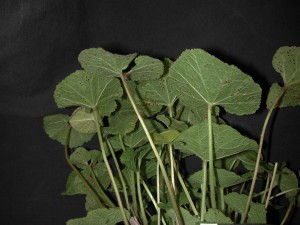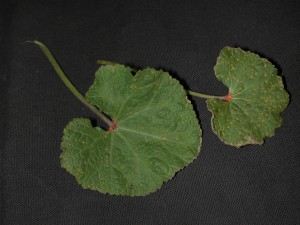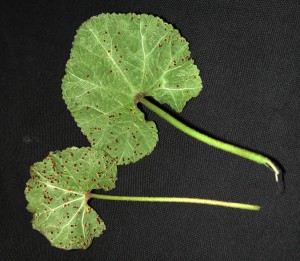Hollyhock rust – Puccinia malvacearum
Pathogen: Puccinia malvacearum
Hosts: Alcea, Althaea, Lavatera, and Malva.
Symptoms: Small brown spots develop on the underside of foliage. Raised, bright yellow or orange pustules are visible on the upper leaf surface. When disease is severe large portions of the foliage are killed.
Spread: Spores can over winter on diseased plant tissues infecting new foliage the following year. Spores are also produced on susceptible weeds these can subsequently infect and cause disease on hollyhocks. Spores are wind dispersed.
Management: Disease control on seedlings is especially important. Fungicide applications at regular intervals are necessary when disease is severe. Plants should be cut back as soon as flowering is done. Plant debris should be removed and destroyed, it should not be composted. Several weeds (in the mallow family) are also susceptible; these weeds should be controlled to limit inoculum in the growing area.



Other Documents in this Series
You Might Also Be Interested In
-
MSU research team receives USDA grant to evaluate effectiveness, cost of new blueberry pest management strategies
Published on February 19, 2021
-
MSU named Top 10 agriculture and forestry college in new report
Published on March 23, 2021
-
MSU researcher awarded five-year, $2.5 million grant to develop risk assessment training program
Published on October 13, 2020
-
MSU Product Center helps Michigan food entrepreneurs survive and thrive throughout pandemic
Published on August 31, 2021
-
Protecting Michigan’s environment and wildlife through the Conservation Reserve Enhancement Program
Published on September 1, 2021
-
MSU Extension to undertake three-year, $7 million vaccination education effort
Published on August 17, 2021
Accessibility Questions:
For questions about accessibility and/or if you need additional accommodations for a specific document, please send an email to ANR Communications & Marketing at anrcommunications@anr.msu.edu.



 Print
Print Email
Email




